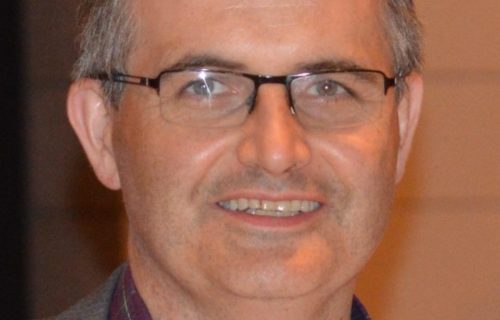Liz makes the call just before midnight. The ambulance is on its way. Her husband, Larry, having gone to bed early that night because he wasn’t feeling well, awoke to severe abdominal pain. What followed the arrival of two paramedics was several hours of compassionate, patient-centred care. “I wish everyone could have the care that Larry received that night”, says Liz.
Following a vacation in late 2017, Larry had a persistent cough that wasn’t going away. Liz and Larry made an appointment to see the doctor for a check-up upon their return. An x-ray revealed that Larry had a spot on his lung—more specifically, a large cell neuroendocrine tumour. The doctor told them the tumour was easily treated, but that if it came back, it could be aggressive. In January 2018, Larry started chemotherapy and radiation treatment. “We kept waiting for him to feel terrible, but he did amazing through it”, says Liz. She describes that winter as a particularly snowy one, and Larry continued snow blowing and shovelling as he had done in winters past.
Larry’s first check up after chemotherapy and radiation went well, and Liz and Larry maintained a positive attitude. They were able to go on a cruise in the early fall but after returning—and another check-up—he was told he would need more treatment. Larry started immunotherapy.
One night in December, Liz and Larry were looking after their grandchildren. During dinner, Larry started speaking, but none of what he said made sense. Liz thought he was fooling around. “It only lasted, maybe, 10 minutes,” says Liz, but the garbled speech had her worried. They went back to their doctor, and after a CAT scan, it was revealed that Larry had a tumour in his brain. They were told the spot was not large and that it was in an accessible place. On New Years Eve, Larry had a radiosurgery procedure to remove the tumour. After the procedure, Larry had a toxic reaction to his immunotherapy treatment and was unable to continue.
Larry’s first check up after the procedure was positive. His doctors discussed the option of doing chemotherapy again, but a lesser dose. Larry agreed, but did not handle this round of chemotherapy well. “It really destroyed him”, says Liz. At that point, Larry met with his oncologist and expressed that he could not go through chemotherapy again.
It was over dinner with friends a few months later where things really changed for Larry. He took one bite of his meal and then couldn’t eat any more. His appetite deteriorated after this and he began experiencing stomach cramping and pain. In early May, a palliative care physician with a local outreach team came to the house to assess Larry. “Larry passed all the ‘tests’,” says Liz, “He could climb the stairs with no problem and was still eating throughout the day.” With the physician, Larry and Liz came up with a plan if his physical capabilities deteriorated further. They completed a do-not-resuscitate (DNR) order and posted it on the china cabinet on the main floor. They would get a bed in the family room if he could no longer make it upstairs. And, ultimately, if it got too hard at the house, he would go to the local hospice. Larry was very clear that he did not want to go to the hospital.
It was a week after the physician’s visit when Liz called 911 just before midnight. Liz phoned her children, some other family members, and some friends. When the paramedics arrived, they immediately noticed the DNR order on the china cabinet and went up to the bedroom to assess Larry and take his history. They asked him if he wanted to be transported to the hospital. Larry said no. They asked him if he was in pain and when he responded with a resounding yes, they worked immediately to make him comfortable. The paramedics phoned the local hospital’s base physician to get approval on their plan for Larry and spoke with the palliative care physician who had seen Larry just the week before. The paramedics provided their assessment and communicated their plan—both physicians agreed.
After administering morphine and oxygen and ensuring Larry was comfortable, the paramedics discussed the options with Liz and Larry. Ultimately, Larry wanted to remain in the comfort of his home. The paramedics stayed for a few hours and every once in a while, they would check in with Larry and ask if he wanted to go to the hospital. “They were making sure they were doing what Larry wanted”, says Liz.
Larry passed away at 3 am. Liz describes it as a bit of a shock, “Earlier in the day Larry had been on a ladder changing the battery to the fire alarm,” says Liz. Not the typical image of a man who was so close to end-of-life.
As Liz reflects on that night and the care provided by the paramedics who attended to Larry, she was so grateful. “It was so impressive, they made it easier. They kept Larry comfortable and they were very caring. They also gave us our space, but remained nearby in case we needed anything,” says Liz. One of the attending paramedics, Brock Browett, had just completed Pallium’s Learning Essential Approaches to Palliative Care (LEAP™) Paramedic course the week before. The training equipped Brock to handle the call and empowered him to have difficult conversations with Liz and Larry.
Liz says that the care she witnessed that night made her not afraid of death. “What Larry wanted was to stay at home and not suffer, and that’s what happened,” says Liz “If only everyone could die that way.”
A survey conducted in 2013 found that 75% of Canadians who had a preference would choose to die in their home if they could get the support they need. With an aging population that is living with complex and life-limiting conditions, it is critically important to provide care that is more in line with patient preferences. Traditionally, paramedic protocols are based on the principle of stabilize and transport patients to the most appropriate emergency department. Pallium’s LEAP™ Paramedic course teaches paramedics and Emergency Medical Service professionals the essential practical knowledge, attitudes, and skills to provide a palliative care approach at home thereby reducing emergency department transfers and providing care that better reflects patient preferences.






